Traditional Spanish Food: 18 Dishes You Must Try Once!
Spain is famous for its food! We have lots of different dishes to try, with something for everyone’s taste. Each region has its special recipes, but you can find famous dishes everywhere. Traditional Spanish food is part of Mediterranean cuisine, which uses olive oil, bread, and pasta (though pasta is more common in Italian food).
The Spanish people also have special dishes for occasions like Easter, Christmas, and summer. Food is super important in Spanish culture, and their recipes have been passed down from generation to generation. So if you visit Spain, make sure to try these 18 popular foods in Spain before you go!

1. Iberian Ham – Traditional Spanish Food

When you come to Spain, you’ll quickly learn how much we love our ‘jamón ibérico’ (Iberian ham). It’s super important to us, almost as much as olive oil! This ham is famous worldwide, and its various kinds are available based on the pig it comes from (white or black pig).
The fanciest one is called Jamón Ibérico de Bellota. However, I must tell you, it’s so tasty it practically melts in your mouth!
2. Potato Omelet
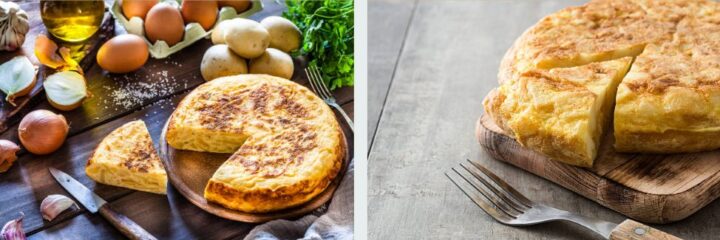
Making a potato omelet might seem easy, but to make it just right, you need some serious skills! This dish is popular all over Spain, especially when families go out for picnics or hikes. You can enjoy it any time of day: for breakfast, as a snack before lunch, or as the main course for dinner!
Here’s a secret: there’s a big debate about whether the ‘perfect’ potato omelet should have onions or not. Ask any Spaniard, and they’ll have a strong opinion about it!
3. Paella

Paella is one of the traditional Spanish food! It originally came from Valencia, but nowadays you can find it everywhere in Spain. This yummy dish is made of saffron-flavored rice mixed with seafood, meats, and veggies.
It’s cooked and offered in a big, shallow pan, and you can get lots of different kinds: seafood paella, vegetarian paella, and meat paella. But the original version from Valencia uses round rice grain, rabbit, green beans, and chicken, fried in olive oil and broth.
4. Gazpacho

Gazpacho is a tasty cold soup from Spain made with tomatoes, peppers, and other vegetables. It’s super refreshing, especially in the hot summer months in places like Andalusia.
Traditional Spanish food gazpacho includes olive oil, tomatoes, water, garlic, vinegar, cucumbers, onions, and green peppers, with bread crumbs to thicken it up.
5. Salmorejo (Porra)
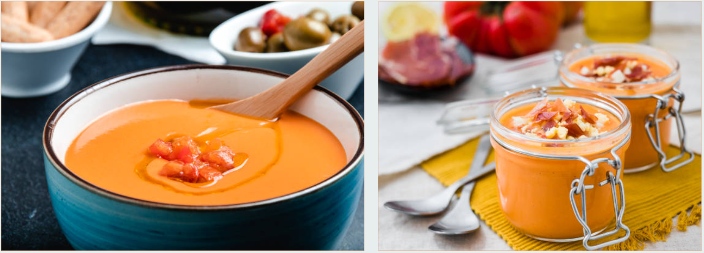
Salmorejo is a delightful dish similar to Gazpacho but with a thicker and softer consistency. It often refers to Porra in the Malaga region and hails from Andalusia. What sets Salmorejo apart is its velvety texture, achieved by blending tomatoes, garlic, olive oil, and bread into a rich, satisfying soup.
It Serves chilled and makes for a refreshing treat on hot summer days. To elevate its taste and presentation, it’s common to garnish Salmorejo with slices of Spanish ham and finely chopped eggs, adding a delightful contrast of flavors and textures.
6. Pil-Pil Prawns
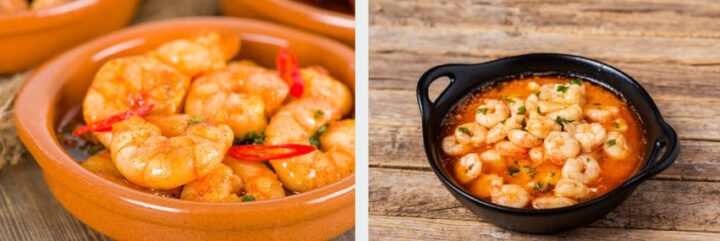
Gambas al Pil-Pil, or pil-pil prawns, is a tantalizing Spanish dish that showcases the culinary prowess of the Mediterranean region. Prepared and presented in a traditional Spanish porcelain pot known as a cazuela, this dish bursts with robust flavors and aromatic spices.
The key ingredients include succulent prawns, sliced garlic, and a generous portion of olive oil infused with fiery cayenne pepper. As the cazuela sizzles over the heat, the flavors meld together, creating a mouthwatering sauce that coats each plump prawn.
It is served as a popular starter in tapas bars across Spain. Pil-Pil prawns offer a harmonious blend of heat, savory goodness, and Mediterranean charm that makes them an irresistible delight for any food enthusiast.
Read More: Different Types of Food Cuisine Around The World
7. Galician-Style Octopus

Galician-Style Octopus is a classic Spanish dish that hails from the Galicia region. It features a bed of thinly sliced potatoes and tender chunks of octopus that are served on a rustic wooden plate. The dish is then generously seasoned with Spanish smoked paprika, sea salt flakes, and drizzled with olive oil. This authentic delicacy reflects the rich seafood heritage and culinary traditions of Galicia.
8. Padrón Peppers
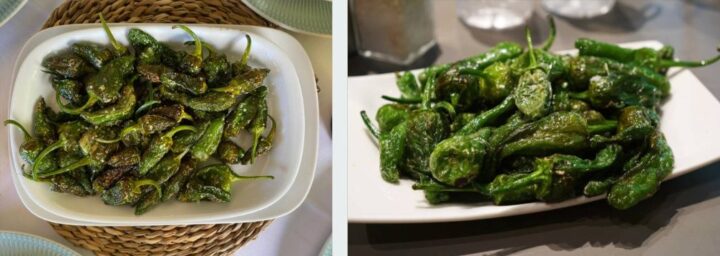
Padrón peppers are a unique type of Spanish pepper originating from the town of Padrón in Northern Spain’s Galicia region. These small green peppers are five centimeters in length and boast a mild flavor profile.
But occasionally, some peppers can pack a surprising heat. It’s a fun culinary adventure because you never know which pepper will be spicy! As the Spanish saying goes, not all Padrón peppers are hot. To prepare Padrón peppers, simply sauté them in warm oil until blister. Then sprinkle with coarse salt and an addictive snack and enjoy the traditional Spanish food.
9. Ensaladilla Rusa

You have to try the classic Russian Salad when you’re in Spain! It’s a beloved dish made with boiled eggs, carrots, peas, potatoes, tuna, and creamy mayonnaise. It’s super tasty!
You can find Russian Salad tapas everywhere in Spain. While this kind of potato salad is popular in other countries like Russia, Italy, and Portugal, the Spanish version is truly special and unique!
10. Croquettes
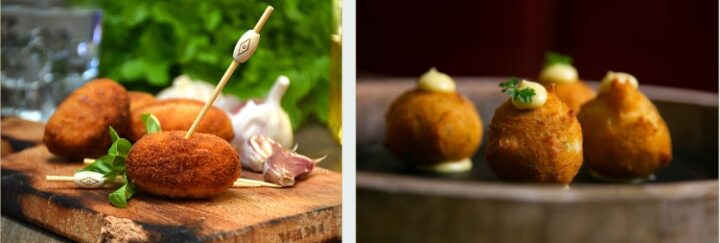
Spanish people are proud of their croquettes, they’ll proudly say, “My mom made the best croquettes,” and you better not disagree! Spaniards are serious about their croquettes. And why wouldn’t they be? These little fried bites are made with a delicious mix of flour, milk or chicken soup, eggs, breadcrumbs, and chicken. They’re a popular tapa all over Spain.
The secret to perfect Spanish croquettes? Lots of time, persistence, and a strong hand to stir the creamy sauce. You can make the tastiest ones with Spanish ham or chicken. It won’t take you long to fall in love with them!
11. Flamenquín
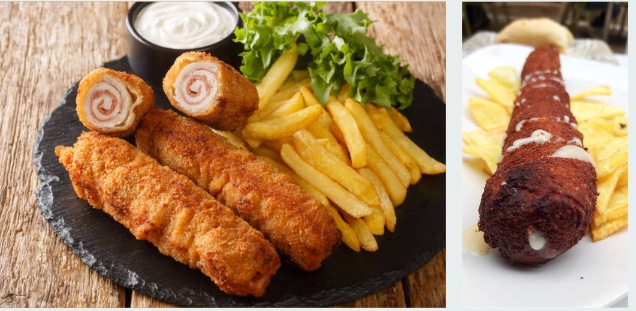
Flamenquín is a famous dish from the Cordoba region. It’s made by wrapping serrano ham slices in chunks of pork loin, coating them in cornmeal batter, and then deep-frying them. Flamenquín comes in different sizes, some even as long as 16 cm! You’ll enjoy this dish if you’re a meat lover!
12. Cocido

Another traditional Spanish food is here. Cocido is like the Swiss Army knife of soups in Spain. Every area has its version, with unique twists and ingredients. One of the tastiest is the ‘Madrileño’ cocido from Madrid, made with black pudding, chickpeas, chicken, beef, chorizo, and streaky bacon.
13. Patatas Bravas
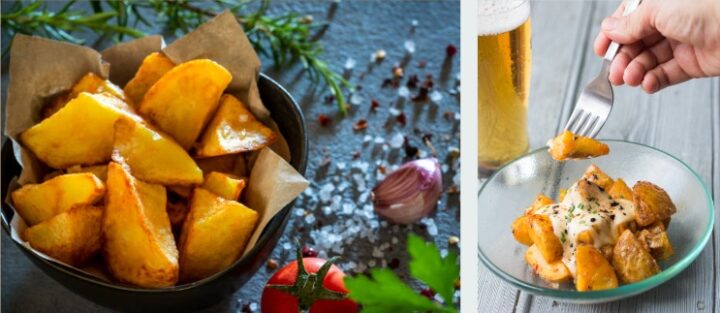
Patatas bravas are a must-try tapa in Spain! They’re the perfect appetizer to enjoy with a glass of wine or a cold beer. The secret to these delicious tapas lies in their sauce. Bravas sauce is a vibrant red color that has a slightly spicy kick to it.
14. Churros

We can’t forget about something sweet as we near the end! Churros are the favorite snack in Spain, commonly enjoyed as a merienda (little meal) between lunch and dinner. You’ll also see Spaniards enjoying churros for the morning meal and at Spanish fairs, where churro food trucks are a common sight.
You’ll need flour, oil, baking powder, and warm water for baking to make churros. Once fried in hot olive oil, they’re coated with sugar and cinnamon for that irresistible crunch!
15. Tapas

You’ve probably heard of tapas before, but let me tell you – you’ve got to try as a lot of them as you can when you’re in Spain! Tapas are tasty starters and munchies that are super popular here. A lot of the items I mentioned earlier are commonly served as tapas in bars all over city centers.
Your drink may even come with a tapa! You can have a beer (caña) with a tapa for just 2€ in Spain. It’s a great way to taste a variety of delicious dishes while enjoying the Spanish vibe.
16. Migas
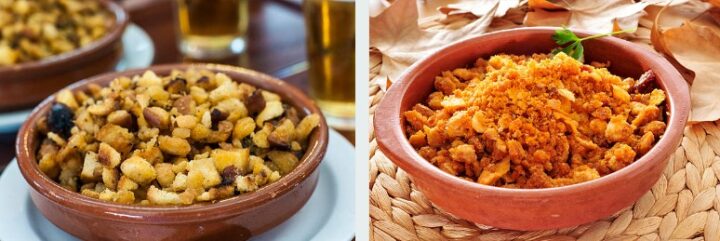
Migas is one of those words that mean different things if you’re Mexican or Spaniard. You can make migas by frying pieces of corn tortillas with veggies and eggs for a delicious breakfast in Mexico. But in Spain, migas take a different route.
Spanish migas start with fried breadcrumbs. Then you can customize it however you like. Often, it includes pieces of pork, like Spanish chorizo, although it varies from region to region.
You can also add in your favorite veggies. Migas is a flexible dish, perfect for using up stale bread and leftovers from your fridge. It’s a delicious way to make a satisfying meal out of odds and ends!
17. Pintxos

The word pintxo covers a range of food items. The Basque area, where it originates, it refers to any tiny dish enjoyed with wine as a snack. Throughout Spain, where these snacks are generally called “tapas,” they specifically refer to the kind presented on a skewer.
While it’s a bit vague what exactly makes up a pintxo, some classics are always available. Many pintxos feature cucumbers and fermented foods threaded onto skewers. One famous example of this is pintxo gilda, made with anchovies, green olive, and pickled guindilla pepper.
A favorite treat is to wrap dates in bacon, fill them with blue cheese, and cook them until crispy. That’s it, now enjoy your traditional Spanish food. Pintxos served on bread are very common, like the Spanish version of bruschetta.
18. Basque Cheesecake

Basque cheesecake gained popularity on the internet. While some trends on the web prioritize looks over taste, Basque cheesecake takes the opposite approach. Its charred exterior and rustic appearance may not be the most Instagram-worthy, but this dessert went viral nonetheless.
The great news is that you can make Basque cheesecake at home. The best part is that this cheesecake requires less effort than the New York-style. No need for a crust or worrying about the top cracking.
The crust basically forms when you bake it until the exterior is crispy. Try this recipe with just six simple ingredients. The reputation for its deliciousness is true!
Traditional Spanish Food and cuisine offers a vibrant mosaic of flavors and traditions that reflect the country’s diverse culture and rich culinary heritage. From beloved classics like paella and tapas to innovative delights like Basque cheesecake, each dish tells a story of history, innovation, and passion.
Whether you’re enjoying a simple pintxo in a local bar or indulging in a decadent feast in a fine dining restaurant, Spain’s cuisine never lets you down. Spain invites you to indulge in its delectable offerings and experience the magic of its vibrant food culture firsthand.


